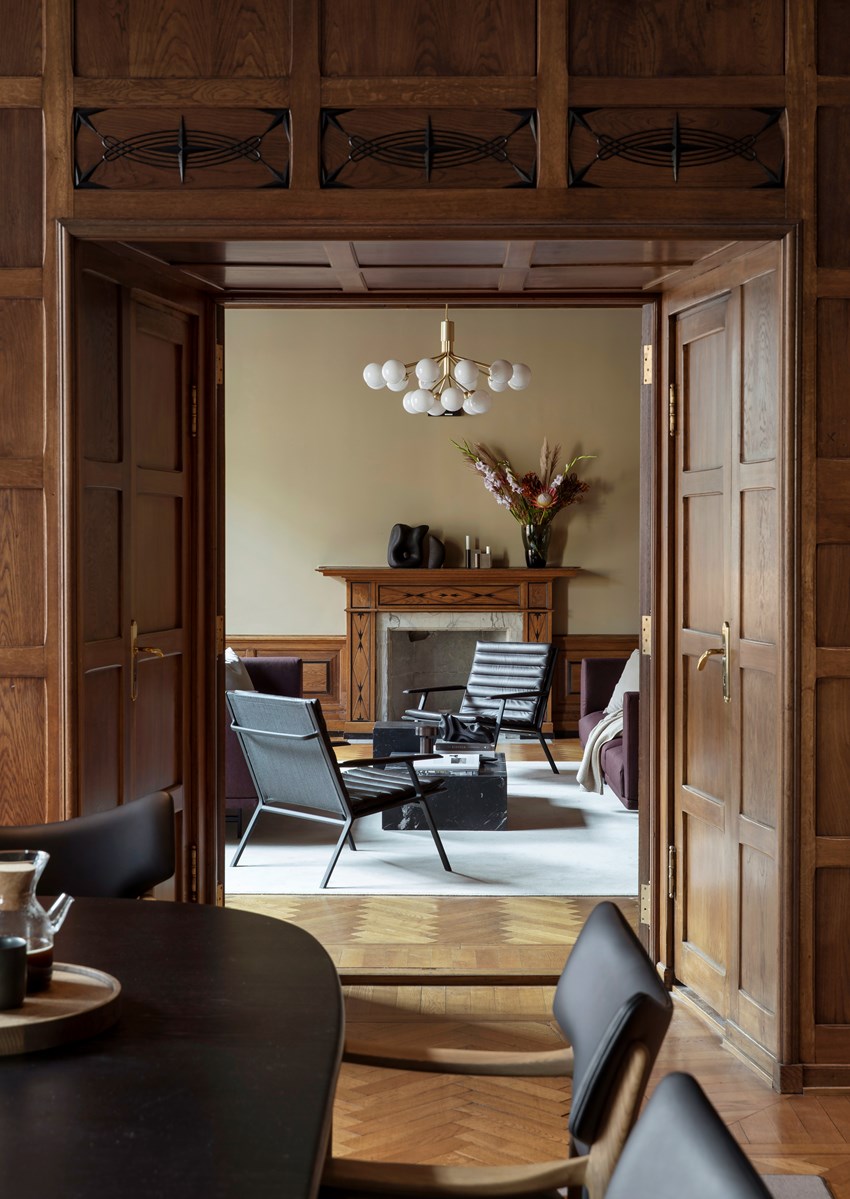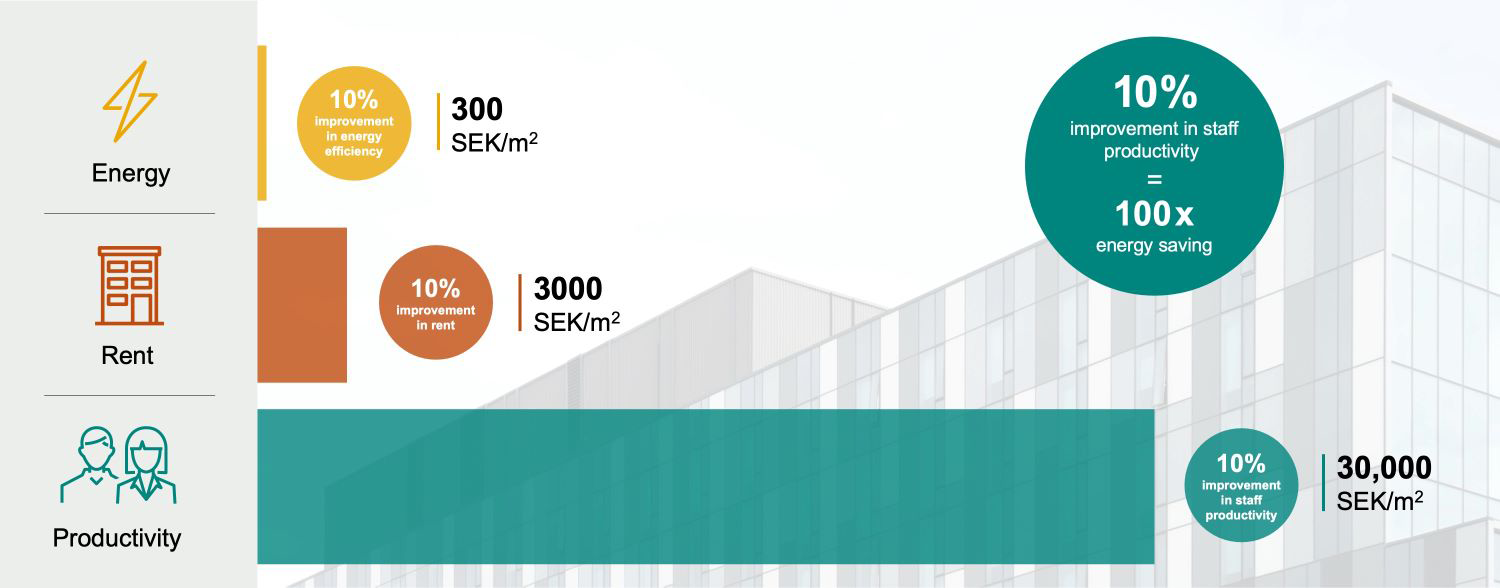Renovating for increased profitability
The impact of a wider sustainability concept
The concept of sustainability has grown during the pandemic and the focus of interest has shifted. Sustainability today does not only focus on planet and profit aspects, but the spotlight is clearly put on human needs and well-being. In the building sector this has given people-first designs a prominent focus, where indoor climate is one of the most important traits. However, we know that up to 50% of the energy used in an office can already be related to ventilation and other indoor climate systems, so in terms of energy usage, ‘more of the same’ will not work. We instead need smarter systems that can produce indoor climate, in a more efficient way.
One way to tackle this contradictory relationship and keep a balanced approach, is to engage in building certifications, for which there is an evident rise in interest. Certifications such as BREEAM, LEED and WELL are with separate approaches driving development in energy efficiency and cost-savings, human health and well-being in a building. It is proven that certified properties, with a long-term sustainable environmental and health perspective, have clear competitive advantages. A study shows an 11% increase in value of certified buildings on the real estate market.
Read our blog Building certifications are on the rise
Sources: Gensler Research Institute (2021) Reconnect, design strategies for a post-covid world, p.11 | Moschini, Paola (2020) Building certifications are on the rise
Sustainability has gone from saving the planet to also saving [humans].Jan Mattsson, CEO at Tengbom Arkitekter in Fastighetsnytt (published April 2021)

The air we breathe is important for our performance
In the industrial world, we spend about 90% of our lives indoors. Meaning that we have been indoors for 72 years by the time we turn 80. Typically we focus on food and water when we want to maximise productivity and wellness. Rarely anyone speaks about the air we breathe even though we know that a good air quality goes hand in hand with both high performance and comfort. The diagram below is illustrating the impact from 10% improvement in three typical evaluation parameters for buildings. Doesn’t it make sense to put the spotlight on the indoor environment quality to increase the workforce’ productivity in a building?
At Swegon we have deep knowledge about air quality and our services, products, and systems are all designed to provide the right solution for the project at hand, renovation or new-build. We know from great experience how to get things right from the outset, we know flexibility both in products and solutions, and we are there for you in every phase of your property development project.
Read about our reference building Telegrafen, Oslo, Norway
Sources: Viscus Partners (2021) 6 office space trends for 2022 | Jones Lang LaSalle (2021) A surprising way to cut real estate costs
This is how your well-being affects the economy of the building

A smart building to deliver on high expectations
In the new era of possible hybrid working models, digitalisation is not only a matter of connectivity. Today we expect almost everything around us to be digitalised and smart, even our buildings and offices. Connected buildings do not only allow a safe return to the office, they also create great opportunities in terms of cost savings and sustainability, along with delivering on today’s high expectations on indoor environmental quality.
A smart building has systems for measuring and regulating the indoor climate according to the values of a wide range of in and outdoor parameters. By intelligently handling the large amount of data, and allowing the systems to wirelessly collaborate, an optimal indoor climate can easily be achieved at the right time. Smart building systems can also provide insight into the operation of the plant serving the building, saving energy, preventing failures and reducing risk and downtime. Regulating the indoor climate to the actual need is smart, it will contribute to financial savings and no unnecessary resources are being wasted. People are normally the most valuable and expensive resource in an office building, a good indoor climate at the workplace contributes to less sick leave and instead allows employees to work together more consistently – an unbeatable saving.
Read our guide Smart buildings
Sources: WSP (2021) How can smart transform the office experience post-covid | Jones Lang LaSalle (2021) A surprising way to cut real estate costs
Renovation and refurbishment - the key to real change
With only 1% of the building stock being new-builds every year, the key to achieving the necessary change to the office is dependent on how we handle the remaining 99% of the buildings. Of which, a stunning 85-95% will still be standing 30 years from now.
As we are renovating buildings to adapt to new needs and working patterns, it makes great sense to consider the energy efficiency of the entire building. Initiatives like the Renovation Wave have highlighted this. Since the indoor climate system typically stands for a substantial part of the energy consumption, it will be a key area to look at for improvement. In doing so, we mustn’t forget about the indoor environmental quality, which has a great impact on human health and productivity as well as the economic bottom line of the building. By choosing easy to install products you have the flexibility to future-proof the building and allow for adaptations to changing tenant needs in the years to come.
Read our blog What is the renovation wave and how can we make it into a real game changer?
Learn more in our indoor climate guide